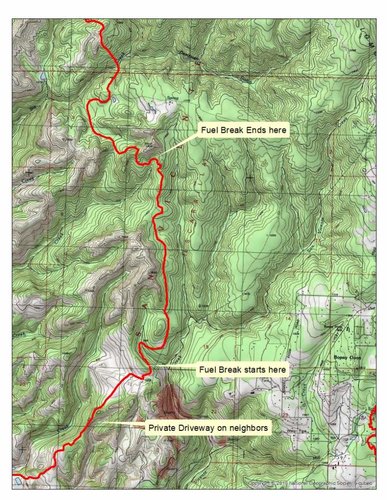Rancho Loco
Well-known member
Look at the topography of the interface in the Los Padres, Angeles, San Bernadino and Cleveland NF's and the Santa Monica mountains. Oakland Hills, Santa Cruz mountains.. I can go on. It's straight up and down.
Follow along with the video below to see how to install our site as a web app on your home screen.
Note: This feature may not be available in some browsers.
Lodgepole is a special circumstance in that it requires fire to regenerate. The stands of Lodgepole are even aged and live for 75 to 90 years, start to die and then the beetles invade. The fire then comes from lightning and replaces the forest. Part of the other problem with Lodgepole is that it really doesn't make a great wood product and most sawmills out west won't even take it.
When I was in CO a couple of years ago, there were only like 2 sawmills in the entire state and trucking would take out any profit. Another problem with Lodgepole is the Mt. pine beetle and you can go in and treat the forest by thinning it out, but you have to get ride of the slash or the beetles will build up in the slash and then attach the trees. This means burn piles of chipping and taking to a biomass plant. There are very few biomass plants because environmentalists have very successfully prohibited more from being built. This is a natural cycle and I don't know if there is a lot that can be done to prevent this. I have a friend who is working in and around Vail and Aspin and they are having a lot of luck with the beetles by disrupting their communication (which inhibits their mechanism to build up and replace full stands) by fermones. This is a new science, and still relies of the trees being healthy. There were some older stands of Lodgepole around Crater Lake, but I think that these burned a couple of years ago. I would be interesting to see if we could get the trees to live longer than their normal stands do and thin them out. I don't have any clients in that ecosystem, so it won't be me, but would be interesting to see.
The pines in the Sierras are different, they have evolved with fire, but in most places, the fires historically weren't stand replacing. The kept smaller trees in check and let the larger trees free to grow. These historic stands had between 30 and 75 trees per acre. Unfortunately California's Forest Practice Rules require the private landowners to plant at 300 trees per acre, which is why you see the landowners come in and thin those stands around 10 to 15 years year old down to maybe 150 trees per acre. We have been working with the regulators to understand that this is part of the issue, but the environmentalists are saying that we are just trying to cut and run. In Idaho, I would agree, I see a lot of shitty forestry which isn't sustainable.............
In California, we have gone from over 200 mills in the 80's to less than 30 now, so our infrastructure has crumbled and we can't process enough of our dead and dying trees even. The Forest Service hasn't cut more than a couple of million board feet annually because every time they put out a timber sale, it gets sued. This is the issue, there is a tax code which needs to be changed that currently allows groups like CBD and The Sierra Club to get paid to sue the Government. They make hundreds of millions of dollars doing this annually.
As for the brush, we can do a lot better job at managing it in places where it matters, those areas around the urban interface. I agree, most of the Mendocino Complex is burning a lot of brush, scrub, and gray pine, which need to burn. Other fires are burning in really nice timber, the west part of the Carr Fire burned across a lot of SPI lands. The Furgeson Fire is burning a lot of private forest lands down south. The brush can be treated with herbicide in places that are in close proximity to communities. This will have to be done every 3 to 5 years to keep it down, or we need to create a very large grazing program. If we had a biomass industry, we could chip all this material and use it for energy production. There is a lot that can be done here, it just takes money. The Forest Service could be generating revenue from timber sales if they wanted to.
Part of my whole reason for bringing up this topic is to point out that while the whole Public Lands initiative is great, it doesn't solve the problem as we need a policy change as well so that the Forest Service can effectively manage their lands. If we don't change this policy, we are going to have more and more people calling for the selling off of federal lands.... We can't deal with just part of the problem, we have to stop saying that there is no problem with the way that these lands are being managed and overturn this shitty tax loophole.
I've been watching this thread pretty closely and have been reluctant to respond as its pretty obvious when someone has just enough "knowledge" to be partially right and a whole lot full of crap. I can tell you think you know about lodgepole stands and forestry, but this statement pretty well illustrates otherwise. Rotation ages for timber production may be 75-90 years (in the best habitat types), but lodgepole stands in the interior West have way longer shelf lives than 90 years, pretty common to see lodgepole stands 150-200+ years old that still haven't experienced stand replacing disturbance. That's for a wide variety of reasons, mainly elevation, aspect, and understory (lack thereof) that's present in most lodgepole mono-cultures. It takes a good combination of things to go "right" before lodgepole experience stand replacing disturbance. Also, lodgepole is a pretty damn important commercial tree and while not as valuable as other species, its extensively logged for veneer, sub flooring, construction grade dimension lumber, post/poles, etc.
It also absolutely does NOT need fire to regenerate.
Thinning lodgepole? Yes, very early pre-commercial thinning and there is absolutely no reason to burn, chip, or otherwise treat the trees you thin. Most LP stands are pre-commercially thinned when they are very young, and very young stand are NOT very susceptible to m-pine beetle. Risk ratings (that I have done a chit load of in the past) are a function of elevation/latitude, age, tree diameter as well as climate, stand density, and other variables. I would like to see some hard evidence of "environmentalists" stopping construction of biomass plants...not saying it cant be true, but some proof of such claims should be provided. I think the market, or lack of a market, drives the construction of mills, biomass plants, etc. wayyy more than enviro-hippies.
Its not that Idaho simply has "shitty" forestry practices/sustainability, its just a function of longgg rotation ages in the interior West. Pretty tough to sustain long-term operations, at profitability levels that support automated and large mills that gobble up timber at break-neck speeds. There isn't enough stumpage that is close enough to mills, with short enough rotation ages, to keep even mid-sized mills operating long term in the IW for a variety of reasons (fuel prices, housing starts, economy, NAFTA, soft wood imports, etc. just to name a few).
Agree, the bigger mills gobbled up the smaller mills via cheap diesel prices and out-bidding smaller mills all through the 80's, same thing happened in Montana, Idaho, etc. The bigger, more automated mills were buying sales hundreds of miles away from the plants and ran the smaller operation out of business. The market driven economy is good for some, not good for others and has a much greater influence over what mills survive and what mills fail than the enviro groups suing the FS. The FS, which by the way, is not mandated to supply an private enterprise with raw products so they can make money. They also have other considerations under the law other than timber production.
Right, and who's going to provide the funding for this? The FS doesn't have enough money to hire trail crews and you're talking about treating vast acreages with herbicides? I suggest you get in touch with reality...the current administration is NOT going to fund increases to the FS budget to complete your "pie in the sky" work projects, just a fact.
Not as simple as just policy change, management costs money. Until the FS, BLM, and even State land management agencies receive adequate funding, you're pissing up a rope. If the land management agencies had adequate funding, to implement the policies already on the books, things would be greatly improved. Don't get me wrong, its great to want to improve management and implement more policy, but that isn't done for free...and the windbags in Congress have NO desire to increase funding to improve management.
I would also like to see improved management via smaller mills supported by a combo of State, Federal, and Private timber, employing locals across the board from tree planting, federal/state agencies, mills, fuels management, etc. etc. that's my "pie in the sky"...that takes funding and commitment from congress. A Congress made up of mostly old, fat, white, male baby-boomers that cant see past the end of their noses and their 3rd vacation home, and that I have lost all faith in doing the right thing. Their track record sucks.
Yep, whole lot of crap in this post.
Much of the private timber company lands and state lands around me are darn near mooscapes at this point. Its staggering the amount of trees being cut and even talking with the loggers they don't see it as sustainable. Also of note, the biggest fires near me the past three years have been on recently logged and replanted ground, they also both stopped when they reached mature, unlogged timber. Its funny for me to hear logging industry radio ads claim they plant 7 trees for each they cut; isn't that a direct contradiction of the claim there are too many trees on the landscape and the reason things need logged and/or thinned? It is also a common practice for them to go back into tree plantations after 5-20 years post planting and thin upwards of 50% of the tree's they planted and leave them lay which to me seems to create a pretty massive fire hazard.
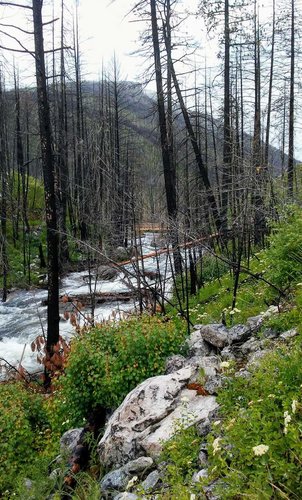
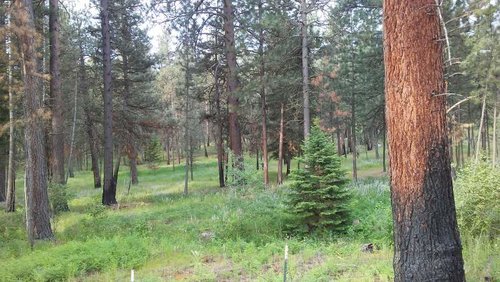
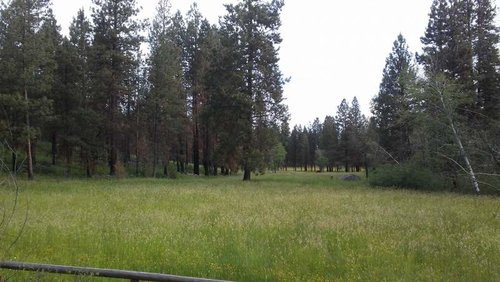
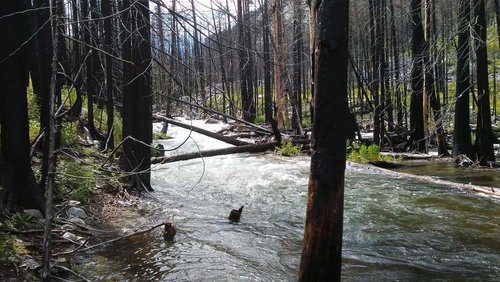
This fire near me from a couple years ago started on National Forest and was human caused. It was scheduled for a thinning treatment at the time but was being delayed by litigation. Unthinned forest, both public and private had almost complete mortality of the trees.
View attachment 86067
Adjacent private property that had been properly thinned, the fire dropped to the ground and ended there.
View attachment 86068
View attachment 86069
Do you have any pictures to share of the fire behavior you are talking about, Tone? Any pictures of the moonscape?
Millions and millions of acres of public forests? And then do it again periodically? At what costs? Paid by whom?... if you aren't going to thin the forests ...
NO, you misread. Your examples work well in small areas and should be models for urban wildland interface areas at wildfire risk.While you don't like the my examples of where this has worked ...
Right ... and then lumber is worth a nickle a stick since there is a glut ... then all the mills, loggers, and truckers work for reduced income ... all while we taxpayers build more roads to thin the vast forests of North America. Is there really such a significant shortage of lumber?You need to mills, loggers, truckers and all the additional infrastructure to make this all happen.
